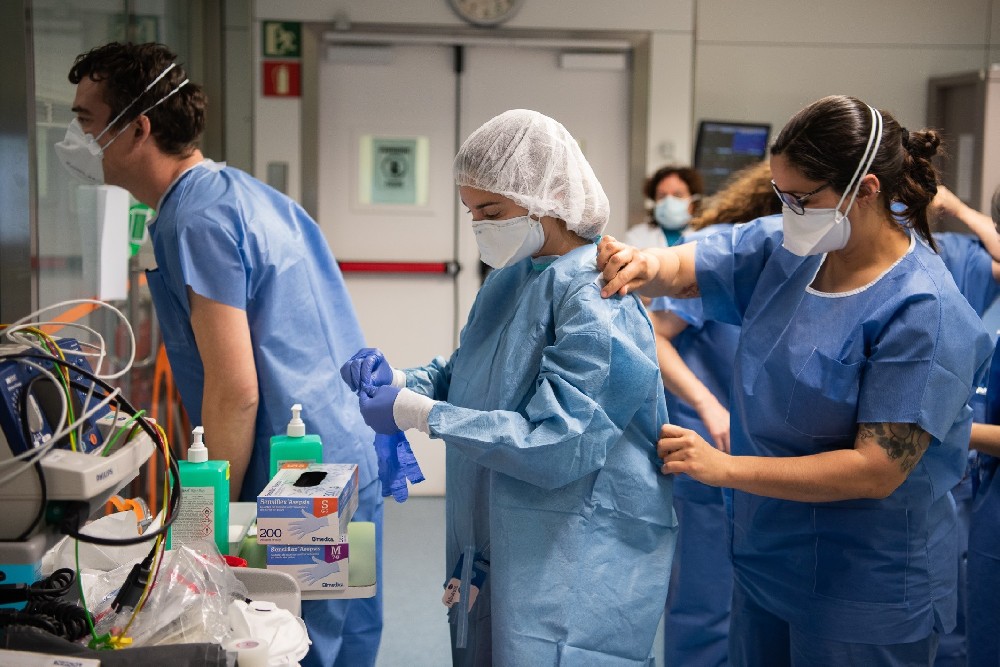Xinhua News Agency, Beijing, September 10 (Reporter Feng Yujing) The World Health Organization's latest global epidemic report shows that since the outbreak of the new crown epidemic, the number of new confirmed cases worldwide has rebounded several times every week. Although the global epidemic has basically remained stable in the past month, the number of new confirmed cases per week is still at a high level.
Analysts believe that the constant emergence of new mutant strains, the arrival of the school season, the premature relaxation of epidemic prevention measures, and the imbalance of global vaccination are all reasons for the current high global epidemic.

On May 13, 2021, a COVID-19 patient in Bangalore, India, sits on a bus to inhale oxygen. This bus provides free oxygen service for patients with new crown who need oxygen. (Issued by Xinhua News Agency)
Variant strains accelerate the spread
The continuous mutation of the new coronavirus has brought severe challenges to the global fight against the epidemic. The WHO recently named the mutant new coronavirus B.1.621, which was first confirmed in Colombia, as the Miu strain, and listed it as a mutant strain that “needs attention”. Preliminary data show that the Myu strain will weaken the effectiveness of antibodies.
According to WHO statistics, there are also Eta, Jota, Kapa, and Lambda strains that are marked as variant strains that require attention; Alpha, Beta, Gamma, and Delta strains are also marked as "needs". Attention” mutant strains. Among them, the delta strain is more infectious than other strains.
Since its first appearance in India at the end of 2020, the delta strain has become the main variant strain currently circulating in most parts of the world . A number of studies have found that this strain has the characteristics of high viral load and fast replication speed, which challenge the protective efficacy of vaccines. A study by the US Centers for Disease Control and Prevention showed that since the delta strain became the main epidemic strain, the overall effectiveness of vaccines approved in the United States has decreased by about one-third. According to data released by the Israeli Ministry of Health at the end of July, due to the delta strain, the effective rate of Pfizer's new crown vaccine in Israel to prevent new crown infections has dropped to 39%.
Another mutant strain, Lambda, which was first discovered in Peru, also spread to many countries, especially in South America, causing more infections. The WHO previously issued a report that there are multiple mutations in the spike protein of the lambda strain, which may lead to a stronger transmission and resistance to neutralizing antibodies than the original strain.
On February 9, 2021, at the San Bartolome National Hospital in Lima, Peru, frontline medical staff were vaccinated against the new crown. (Issued by Xinhua News Agency)
Rebound in the first school season due to the epidemic
At the beginning of the school season around the world, a large number of students are returning to school. Due to the limited coverage of vaccines, children and adolescents are at higher risk of infection when faced with mutant strains.
With the opening of primary and secondary schools, the new crown epidemic in Slovenia has rebounded. According to data released by the Sri Lankan government, only on the day of school starting on September 1, 55 new cases of new crown were confirmed in the country, the highest number of new confirmed cases in a single day in 5 months. According to Irish media reports, since the start of school at the end of August, at least 10 primary and secondary schools across the country have found confirmed cases of the new crown, and some schools or classes have been forced to close. In September, many Japanese elementary and middle schools opened one after another, and Tokyo is facing a severer new crown epidemic than ever before. Japanese epidemic prevention experts believe that one of the characteristics of this wave of epidemic is that it is transmitted from children to family members.
According to data released by the American Academy of Pediatrics on September 7 , child cases accounted for more than a quarter of the new confirmed cases of new crown every week in the United States at this stage . The number of cases of COVID-19 in children declined at the beginning of this summer, but has since "increased exponentially." More than 750,000 children were infected from August 5 to September 2, but it is rare to develop severe illness. Since the outbreak, more than 5 million children in the United States have tested positive for the new coronavirus.
On September 7, 2021, in a middle school in Nicosia, Cyprus, a teacher checks the students' COVID-19 safety passes. (Issued by Xinhua News Agency)
Relax too early to bury hidden dangers
As the epidemic situation improved in June, some European countries eased epidemic prevention and control. Cyprus allows part of the entertainment and catering industries to resume business, Spain has abolished the requirement to wear masks outdoors, and the UK has even cancelled the requirement to wear masks in indoor public places.
In response, health experts issued a warning. Scholars from Queen Mary University of London, University of Oxford, University of Leeds and other institutions published an open letter in the international medical journal "The Lancet" on July 7th, stating that the British government's decision to implement the final phase of "unblocking" in England was "dangerous and hasty. ".
When the delta strain is coming, many parts of the United States have prematurely relaxed the epidemic prevention measures such as wearing masks in public and maintaining social distancing. In May, the US Centers for Disease Control no longer recommends people who have completed the new crown vaccination to participate in the room. You must wear a mask during outdoor activities. Subsequently, the epidemic rebounded sharply in July, and many places had to restart the “mask order”.
On August 20, 2021, volunteers checked personal information filled in by citizens outside a new crown vaccination site in Johannesburg, South Africa. (Photo by Xinhua News Agency reporter Chen Cheng)
Imbalanced vaccination
Mass vaccination has helped many countries effectively fight the epidemic. In some areas with high vaccination rates, both the severe illness rate and the mortality rate have dropped significantly, but vaccination has shown a serious global imbalance, and the vaccination rate in underdeveloped countries and regions is generally low.
According to WHO data, as of the end of July, only slightly more than half of the countries had a coverage rate of 10% for the new crown vaccine, less than a quarter of countries had a coverage rate of 40%, and only three countries had a coverage rate of 70%. At the same time, the number of new crown vaccines on the African continent has been less than 2% of the total number of vaccinations in the world, and only 1.5% of the African population has completed the vaccination.
In some countries, some people have low willingness to vaccinate. Fauci, director of the National Institute of Allergy and Infectious Diseases, recently said that 75 million people in the United States are eligible for vaccination but have not yet received the new crown vaccine. South Africa’s Deputy Minister of Health Sibongiseni Delomo previously introduced measures to the parliament to combat the new crown epidemic and pointed out that some people in South Africa have low willingness to vaccinate, and the fight against the epidemic poses a major challenge.
phone number
Scan WeChat
